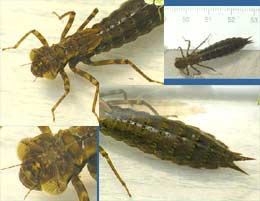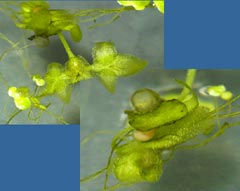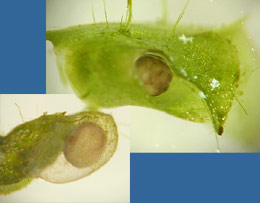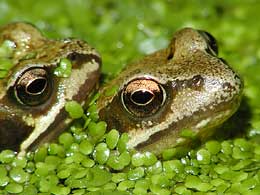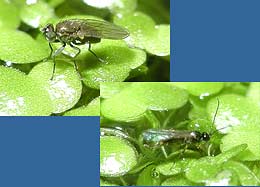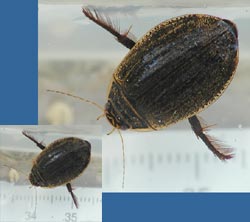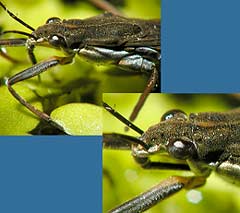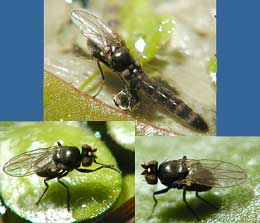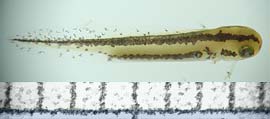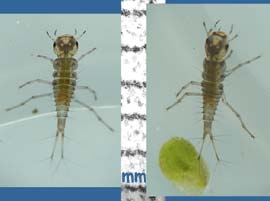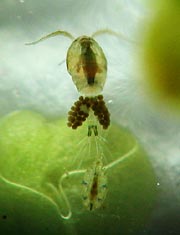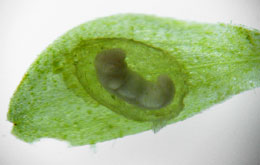Go to last entry........................................Go to previous entry
I have included the photographs as the main ones are a bit sharper than the previous images.
In my last entry, I mentioned Ivy-leafed Duckweed. Well, here it is, complete with a couple of newt eggs. The Ivy-Leafed Duckweed is much more interesting to look at than the Common duckweed. In the lower image one egg is clearly visible and you may just make out the colour of the second, hidden egg in the curled leaf below it.
With the two species mixed together at the surface , removing the common Duckweed is not possible now, until the eggs have all developed, and the newtlets have grown enough to be seen easily.
In the upper picture you can see that the egg has reached the early blastula stage of its development, with the large cells giving it a bubbly appearance. I think the larger, lighter cells towards the bottom left of the embryo are the yolk cells which will later develop to form the internal organs such as the newt's gut.
The lower image shows an embryo in a somewhat later stage of development (one clue that it's not newly laid is the amount of algae developing on the outside of the albumen). Looking closely at the large image of the embryo I can just see signs that it may have reached the neurula stage, when it starts to develop the neural plate from which the newt's spinal cord and brain will develop.There appears to be a very faint 'shadow' running part of the way from top-right towards the bottom-left across the middle of the embryo. Also, the symmetrical pattern of darker areas around the edge of the oval suggest an embryonic shape developing.
While the growing vegetation makes it difficult to do a count, there must be several dozen frogs active in the two ponds at the moment.
The leaves of the plant form 'rosettes' as shown in the top-left picture. The first sign that the plant is flowering is when tiny yellow anthers appear between the leaves (top-right) and perch above the water on a sturdy stalk (filament). When the anther bursts open to release pollen, a very close look at the plant reveals the stigmas of the female flowers. These appear as thin green stalks , usually on the opposite side of the leaf rosette from the anther of the male flower (lower picture).
There are plenty of suitably sized insects constantly moving about the surface. These two pictures show a couple of them moving about on the duckweed. I am unlikely to identify either species.
I had been treating some timber and went out into our driveway to wash the container and brush. Once that job was done I started to brush away the puddle of water and noticed something splashing about in the soapy water. It was a case of rushing it to the birdbath to rinse it off (the bird bath water waschanged afterwards), before taking some photographs prior to putting it into the big pond. Measuring about 18mm in length, I think it is an Acilius sulcatus which is found in ponds or slow moving water. The ribbed elytra (its back) indicates that it is a female.
This evening I was by the pond again, with my camera set up for close-ups. My first target was this pond skater which was doing what they often do - waiting until they detect vibrations on the water surface which would indicate the presence of possible prey. As it waited, it lowered its piercing rostrum briefly, presumably to drink. The two pictures show it down and then raised back to its 'stored' position. Getting these pictures was a coincidence following the pictures I took of the Common Green Shield Bug this morning (see garden diary). Both insects are bugs, with this rostrum structure, which is essentially like a hypodermic needle with which the bug sucks up juices. The big difference between the two is that while the Shield bug is a vegetarian, the pond skater is a carnivore.
The fly pictured here is barely 2mm long and that poses problems. The camera has to be hand held over the pond just centimetres from a tiny target that hardly stops moving - I wouldn't even bother trying with a film camera! These three images are the nearest I could get, and they show the wing vein pattern (clearly enough for me to be fairly sure that the fly belongs to the Ephydridae, a group known as shore-flies.
13 May - After noticing that the water butt overflowed in the rain yesterday I spent a few minutes this morning clearing some of the pond weed that had grown around the overflow outlet in the big pond. A quick job turned into a longer, careful sorting of the weed as I found dozens of very young, and very small cockles amongst it.
I also came up with fresh newt eggs as they continue to lay.
It is nothing like the dragonfly or damsel fly larvae, and, based on the pair of 'tails', could be the larva of a diving beetle. I should explain that the mm scale added to each of today's pictures was photographed at exactly the same camera settings as the images themselves.It is then added to the image before any size changes are made.
Any water scooped out of the pond will contain these creatures which can be seen swimming around with jerky movements.
Not a ggod image, but I've included it to show a newt embryo in a 'mid' stage of development.
|
|
